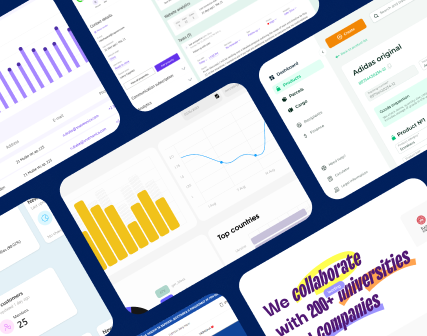Survey: interface strategies for retail businesses in 2026
Do companies allocate a budget for usability research of their interfaces? Who in the companies is responsible for conversion optimization? What tools and measures do companies use to increase project conversion? Does everyone have a designer and a CRO specialist as part of their in-house team? Below are the answers to these and other questions based on a survey conducted by the Turum-burum agency.
The relevance of online trading and e-commerce has reached its peak, so the Turum-burum team, specializing in usability and interface creation, conducted a survey regarding the place of interface, usability, and conversion optimization issues in the current strategy of companies.
Market players: who participated? The survey included representatives of medium-sized businesses with monthly traffic of 50K visitors and more in the following niches:
- Fashion (28%)
- Electronics (15%)
- FMCG (13%)
- Sporting Goods (10%)
- Drogery (10%)
- Jewelry (5%)
As well as Finance, Furniture, Textiles, Gardening Products, Tires, Beauty, Fintech, Metal Products, QSR, Gifts, and Healthy Food.

Most of the respondents held managerial positions, including business owners (7.7%), e-commerce directors (33.3%), marketing directors (30.8%), digital directors (10.3%), and other specialists making strategic decisions about the need for interface changes.

Conversion rate optimization (CRO) activities: budget, team, regularity?
Separate budget allocation for CRO (conversion rate optimization through interface changes) The survey showed that most companies do not allocate funds for conversion optimization and usability.
These expenses are most often either approved by a separate budget (43.6%), not provided in the budget at all (28.2%), or part of the marketing budget (15.4%).

Who in the company makes strategic decisions about the need for interface changes (position)
The length of the decision-making chain and approval of interface changes affect the efficiency and speed of the project. So, we needed to know how many people and which ones are most affected by e-commerce issues today.
According to the data obtained, strategic decisions regarding interface changes are most often made by:
- E-commerce director: 28.2%;
- Business owner: 20.5%;
- Marketing director: 17.9%;
- Digital director: 10.3%;
- Product owner: 7.7%;
- Other: Collegially (CMO, CEO, owner, PO); Project manager; Varies.

The presence of in-house design teams and CRO specialists
According to the survey, only 5.2% of companies have their own design department. In 30.8% of companies, there is an in-house designer or team, yet, they also involve external specialists for additional work, and another 30.8% have an in-house designer working on projects independently. Additionally, 15.4% of companies outsource design projects to contractors and 17.9% hire freelancers for project-based work.

Usually, companies do not have separate conversion optimization specialists. Only 5% of companies have an in-house CRO specialist, and another 4% have their own CRO team. Meanwhile, 32% of companies said that this function is performed by other departments (there is a designer or team without CRO skills and no separate budget for conversion optimization), which can significantly affect the quality and efficiency of CRO. However, 38.5% involve separate CRO specialists for such work.

How often do companies conduct conversion optimization work?
According to the survey, 38.5% of companies conduct conversion optimization work only once every few years or not at all. However, 23.1% of companies constantly engage in conversion optimization and project usability.

Analytical tools: what do they use?
The quality of collected data plays an important role in choosing a CRO strategy and the effectiveness of conversion optimization. Therefore, the analytical tools used by companies play a crucial role.
The survey found that everyone uses Google Analytics, but 35.9% of companies have issues with the tool's setup and data quality. This shows the importance of using multiple tools for user analysis and the need to find specialists to set up analytics correctly to track the project's key KPIs.
According to the survey, it's also noted that Hotjar and Microsoft Clarity are the two most used analytics tools among online retailers. Less popular are Plerdy, Optimizely, Crazy Egg, UXPin, and Mixpanel.

Effective CRO and target audience research also require tools that help to better understand user behavior, identify interface problem areas, and find effective ways to solve them.
The survey showed that the most common methods include collecting feedback from customers (66.7%), digital analytics (61.5%), UX/UI changes in the interface (56.4%), and copywriting (56.4%). Other frequently used tools include click and scroll maps, session recordings (46.2%), A/B testing (43.6%), personalization (23.1%), user testing (15.4%), on-site surveys about interface convenience (15.4%), and eye tracking (2.6%).

While tools and analytics are important for successful conversion optimization, internal processes, and employee qualifications also have a significant impact on CRO efficiency. Therefore, the next question focuses on the main problems modern companies face when optimizing conversions.
A surprising finding is that 53.8% of companies said that not having a CRO in their development strategy is the main concern. Other concerns included a lack of employee qualifications (35.9%), poor data (35.9%), and unorganized team processes (25.6%).
This shows again how critical it is to integrate CRO into the company's overall strategy and to ensure proper team training.

Forecasts and trends
Modernity has changed consumer behavior, with more people using online channels for shopping and interacting with brands. This has increased the demand for specialists who can adapt and improve the user experience, so:
- The demand for CRO specialists and conversion optimization services will grow due to the increasing complexity of the business environment and the growing need for qualified specialists to manage online projects and optimize client engagement and conversion processes effectively.
- Companies are increasingly recognizing the value of data and analytics for making informed decisions. Therefore, the importance of attracting and correctly setting up tools for collecting and tracking quantitative and qualitative data is growing.
- Implementing CRO as a separate item in the business development strategy. This includes using A/B testing, analytical tools, UX design, etc.
Realizing that most companies underestimate the opportunities and importance of conversion optimization through usability improvements, the Turum-burum team decided to create a series of useful materials for online business development based on their 14 years of experience in the e-commerce field.
The main goal is not only to share knowledge about typical UX/UI design mistakes, but also to provide practical advice that is relevant today and based on real examples. Also, we want to show how thorough analysis and the use of analytical tools can improve the user experience and thus increase conversions.
FAQ
Question reference
Answer reference
More real-world Turum-burum cases?
Review our vast portfolio of cases in a variety of business fields to make sure of our expertise.
Go to Portfolio








%20(1).png)










